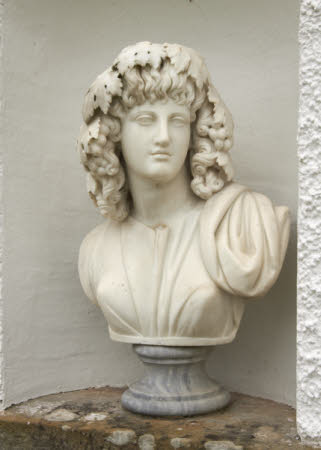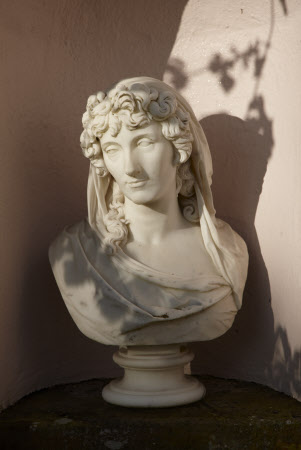Portrait bust of an unknown woman, displayed as an Allegory of Spring
Christopher Hewetson (Thomastown c. 1736 - Rome 1798)
Category
Art / Sculpture
Date
c. 1780 - 1798
Materials
Marble on marble socle
Measurements
625 x 410 x 240 mm
Place of origin
Italy
Order this imageCollection
Ardress House, County Armagh
NT 247725.4
Summary
Sculpture, marble; Portrait of a woman, an ‘Allegory of Spring; Christopher Hewetson (c. 1736-1798); Italy, Rome, c. 1780-98. A marble bust of an unknown woman by the Irish sculptor Christopher Hewetson, who worked for almost his entire career in Rome. Displayed at Ardress as ‘Spring’ within a group of four heads depicting the Seasons.
Full description
A marble portrait bust signed by Christopher Hewetson (c. 1736-1798) depicting an unknown woman, looking slightly to her right. She wears a loose dress and over her head a veil. Signed on the edge of the proper right side of the bust. Mounted on a turned marble socle. The sculpture is one of four busts of females at Ardress (NT 247725.1-4) set in niches on the Garden Front of the house, which was redesigned by the second George Ensor (1772-1845). He may be presumed to have acquired the busts and to have installed them as part of the remodelling, but it is not known when and from where they came into his possession. They have long been presented as allegories of the Seasons: Spring, Summer, Autumn and Winter, and all four have hitherto been attributed to Christopher Hewetson, although in fact only the present sculpture is signed by him. Of the other three works, two (NT 247725.1-2) are copies after well-known antique models, whilst the fourth appears to be wholly modern and later than the other sculptures in this composite group. This beautiful sculpture clearly originated as a portrait of an unknown woman and, as such, has nothing to do with the season of Spring. Appreciation of its qualities has hitherto been obscured by its being considered a generalised allegorical work, lumped together with three other quite different sculptures. It is tempting to try to identify this strongly characterised individual with one of the portrait busts of female sitters that Hewetson is known to have made in the course of his career. His portraits of women are much rarer than those of men. They include unlocated and undescribed portraits of Emma, Lady Hamilton (1765-1815; Breffny 1986, no. 12), which it is known had not been paid for at the time of Hewetson’s death, and one of the painter Angelica Kauffmann (1741-1807; Breffny 1986, no. 14). Neither of these well-known females would seem to be the sitter in the marble bust. After his death on 15 November 1798, an inventory was made of the contents of Hewetson’s workshop, including a number of portrait busts, mostly of British sitters, in various stages of completion. The two female sitters within this group were, firstly, 'Lady Carneghi’, presumably Agnes Murray Elliot (1763-1860), wife of the Scottish politician Sir David Carnegie (1753-1805) (Coen 2012, p. 97; Suárez Huerta 2014, p. 8, no. 3), and secondly ‘Miledy Plymouth’, the bust described as finished (‘compito’. Coen 2012, p. 98; Suárez Huerta 2014, p. 10, no. 14). This must have been Sarah Windsor, Countess of Plymouth (1762–1838), the botanist and naturalist who became Countess Amhurst through her second marriage. Both women would have been in the their mid-thirties when they were being modelled by Christopher Hewetson, which would seem to correspond to the age of the sitter in the Ardress bust. All fourteen of the modern busts listed in the inventory had already been paid for, so it might seem improbable that they were not all sent to the person who had commissioned them, as indeed happened with the bust of Sir John Throckmorton, discussed below. However, an argument for the possible identification of the Ardress portrait as one of the busts in Hewetson’s studio at the time of his death is the form of the signature, ‘HEWETSON FECIT’ ('Hewetson made this’). Hewetson invariably included some form of his first name Christopher in his other recorded signatures, so this might imply the signature was added after the sculptor’s death, by a member of his workshop. Christopher Hewetson’s principal assistant at the time of his death was the sculptor Cristoforo Prosperi, also named by Hewetson as the main beneficiary of his will. The portrait bust of Sir John Courtenay Throckmorton, 5th Bt (1754-1819) at Coughton Court (NT 135688) is also among the fourteen modern portrait busts in the inventory (Coen 2012, p. 97; Suárez Huerta 2014, p. 8, no. 2), described as two thirds completed , the inscription applied to the bust in 1800 confirming that it was finished by Prosperi. It is on an identical entablature and socle to the portrait of a woman at Ardress. It is also possible that another of the busts at Ardress, the ‘allegory of Autumn’, in fact a copy after a figure of the Muse Melpemone (NT 247725.2) was also in Hewetson’s workshop at the time of his death. Jeremy Warren June 2022
Provenance
Presumably acquired by George Ensor (1772-1845).
Marks and inscriptions
On proper left edge of bust:: HEWETSON FECIT Number 1 signed on back Christopher Hewitson Fecit
Makers and roles
Christopher Hewetson (Thomastown c. 1736 - Rome 1798), sculptor
References
Breffny 1986: Brian de Breffny, "Christopher Hewetson’, Irish Arts Review, 3, no.3 (1986), pp. 52-75. Coen 2012: Paolo Coen, ‘Christopher Hewetson: Nuovi documenti, nuove interpretazioni’, Bollettino d’Arte, 7th.Series, no. 15 (2012), pp. 87-100 Suárez Huerta 2014: Ana María Suárez Huerta, ‘Will and Inventory of Christopher Hewetson (c1737–1798)’, The British Art Journal, 15, no. 2 (2014), pp. 3-17, p. 7.



